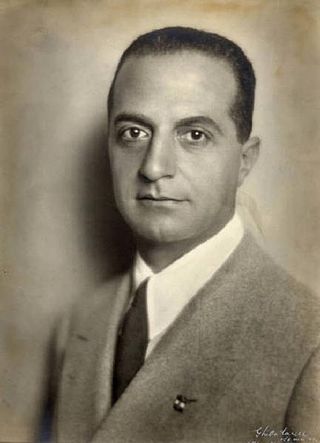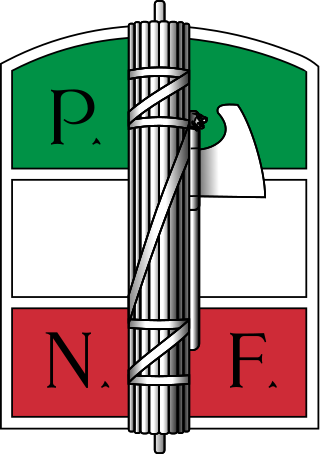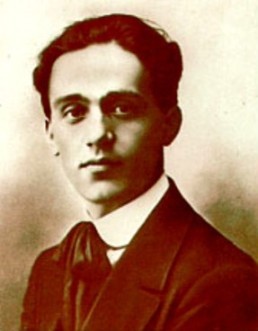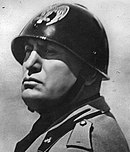"The Manifesto of the Italian Fasces of Combat", also referred to as the Fascist Manifesto or the San Sepolcro Programme being the political platform developed from statements made during the founding of the Fasci Italiani di Combattimento, held in Piazza San Sepolcro in Milan on March 23, 1919.

Duce is an Italian title, derived from the Latin word dux 'leader', and a cognate of duke. National Fascist Party leader Benito Mussolini was identified by Fascists as Il Duce of the movement since the birth of the Fasci Italiani di Combattimento in 1919. In 1925 it became a reference to the dictatorial position of Sua Eccellenza Benito Mussolini, Capo del Governo, Duce del Fascismo e Fondatore dell'Impero. Mussolini held this title together with that of President of the Council of Ministers: this was the constitutional position which entitled him to rule Italy on behalf of the King of Italy. Founder of the Empire was added for the exclusive use by Mussolini in recognition of his founding of an official legal entity of the Italian Empire on behalf of the King in 1936 following Italy's victory in the Second Italo-Ethiopian War. The position was held by Mussolini until 1943, when he was removed from office by the King and the position of "Duce" was dismantled, while Marshal Pietro Badoglio, 1st Duke of Addis Abeba was appointed Presidente del Consiglio.
Fascio is an Italian word literally meaning "a bundle" or "a sheaf", and figuratively "league", and which was used in the late 19th century to refer to political groups of many different orientations. A number of nationalist fasci later evolved into the 20th century Fasci movement, which became known as fascism.

Giuseppe Bottai was an Italian journalist and member of the National Fascist Party of Benito Mussolini.

The Biennio Rosso was a two-year period, between 1919 and 1920, of intense social conflict in Italy, following the First World War. The revolutionary period was followed by the violent reaction of the fascist blackshirts militia and eventually by the March on Rome of Benito Mussolini in 1922.

Unione Sindacale Italiana was an Italian anarcho-syndicalist trade union. It was the Italian section of the International Workers' Association, and the name of USI was also abbreviated as USI-AIT.

The Fasci Italiani di Combattimento was an Italian fascist organisation created by Benito Mussolini in 1919. It was the successor of the Fasci d'Azione Rivoluzionaria, being notably further right than its predecessor. The Fasci Italiani di Combattimento was reorganised into the National Fascist Party in 1921.

Ida Irene Dalser was the first wife of Italian fascist dictator Benito Mussolini.
Squadrismo was the movement of squadre d'azione, the fascist militias that were organised outside the authority of the Italian state and led by local leaders called ras. The militia originally consisted of farmers and middle-class people, who created their own defence from revolutionary socialists. Squadrismo became an important asset for the rise of the National Fascist Party, led by Benito Mussolini, and systematically used violence to eliminate any political parties that were opposed to Italian Fascism.

The National Fascist Party was a political party in Italy, created by Benito Mussolini as the political expression of Italian fascism and as a reorganisation of the previous Italian Fasces of Combat. The party ruled the Kingdom of Italy from 1922 when Fascists took power with the March on Rome until the fall of the Fascist regime in 1943, when Mussolini was deposed by the Grand Council of Fascism. It was succeeded, in the territories under the control of the Italian Social Republic, by the Republican Fascist Party, ultimately dissolved at the end of World War II.
Cesare Rossi was an Italian fascist leader who later became estranged from the regime.

Filippo Corridoni was an Italian trade unionist and syndicalist. Born in Pausula, today Corridonia, he was a friend of future Italian fascist dictator Benito Mussolini. Between 24 and 25 January 1915, the Fasci d'Azione Rivoluzionaria were founded in the presence of Corridoni and Mussolini, among others. That same year, numerous left-interventionists were called up, including Corridoni and Mussolini themselves. In October 1915, Corridoni died during the Great War, being hit in the head by an Austrian-Hungarian Army bullet at the Trincea delle Frasche in San Martino del Carso. Between 1914 and 1915, he had been part of the left-interventionism movement that supported the Kingdom of Italy entry into the Great War, and was pictured taking part to a 1915 interventionist demonstration in Milan. This stance costed him, among others, the expulsion from the Unione Sindacale Italiana, whose Milanese section he was leading. These went on to join with Futurist interventionism, which was already creating unrest in the squares with Filippo Tommaso Marinetti and Umberto Boccioni.
This is a list of words, terms, concepts, and slogans in the Italian language and Latin language which were specifically used in Fascist Italian monarchy and Italian Social Republic.
The Fascio Rivoluzionario d'Azione Internazionalista was a political movement that advocated Italy's participation in World War I on the side of the Triple Entente against the Central Powers. The movement's manifesto was drawn up on 5 October 1914 by revolutionary syndicalists and left interventionists former members of the Unione Sindacale Italiana. The usefulness of the First World War was asserted as an indispensable historical moment for developing more advanced societies in a political-social sense. The manifesto inspired the formation of the Fasci d'Azione Rivoluzionaria.
Sansepolcrismo is a term used to refer to the movement led by Benito Mussolini that preceded Fascism. The Sansepolcrismo takes its name from the rally organized by Mussolini at Piazza San Sepolcro in Milan on March 23, 1919, where he proclaimed the principles of Fasci Italiani di Combattimento, and then published them in Il Popolo d'Italia, on June 6, 1919, the newspaper he co-founded in November 1914 after leaving Avanti!

The Piazza San Sepolcro is a piazza in the center of Milan not far from the Piazza del Duomo.
In the First Italian Republic, after the Second World War, many armed, paramilitary, far-right organizations were active, as well as far-left ones, especially in the Years of Lead.
Left-interventionism was the part of the progressive interventionist movement of various left-wing matrices, such as those of Mazzinian, social reformist, democratic socialist, dissident socialist, reformist socialist, and revolutionary socialist persuasions, that saw in the Great War the historical opportunity for the completion of unification of Italy, and for those who later became part of the Italian fascist movement, such as Benito Mussolini, as the palingenesis of the Italian political system and the organization of the economic, legal, and social system, and therefore a profound change.
The proprietary corporation is a concept proposed during Italian fascism by fascist political philosopher Ugo Spirito, in which a corporation, akin to a guild, assumes ownership of a company in which its members operate. This was proposed as a class-collaborative means to end the dualism between capital and labor via the transfer of the means of production to the corporation.
The 1st Congress of the Fasci Italiani di Combattimento was held in Florence on 9 and 10 October 1919, following the proclamation of the Sansepolcro program on 23 March of the same year by Benito Mussolini.










